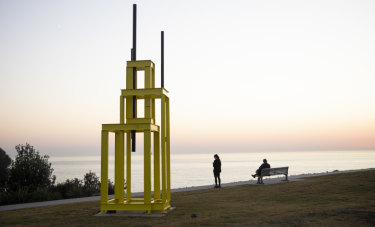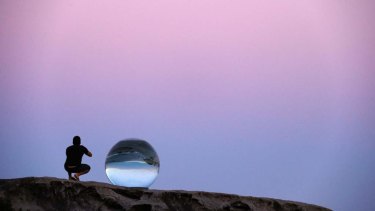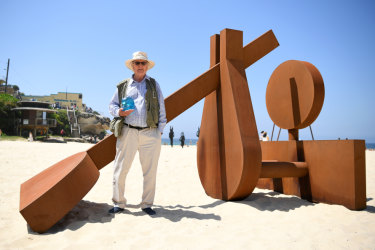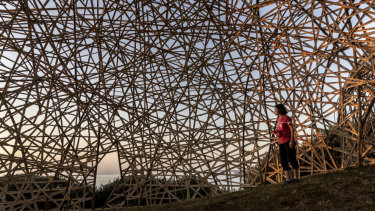Proof arrived this week that climate change is real and urgent. The standard beginning of Sculpture by the Sea sees visitors plodding around the coastal trail between Bondi and Tamarama in the pouring rain, but the first day of this year’s show was a scorcher. When the magical rain-bringing powers of this event are exhausted it’s time to get worried.
A more immediate issue haunting the show is the ongoing stoush between founding director David Handley and Waverley Council over a new concrete pathway intended to assist disabled access. Handley believes the path and some luridly coloured exercise areas have fatally compromised the exhibition, making it harder for artists to position their works. He has already signalled his openness to offers from alternative sites.
I took a look at the dreaded concrete path this week and must confess I can’t see what all the fuss is about. Firstly, it’s hard to argue against better disabled access, secondly the stretch of territory between Bondi and Tamarama wasn’t exactly an unspoiled wilderness prior to the new additions. As for the exercise facilities they are so garish I initially thought they must have been designed by architects Ashton Raggatt McDougall. These may be the preferred colours for people who like to wrap themselves in lurex and flex muscles in public, but I’m not sure they should be encouraged.
Either way, it’s not a catastrophe. During two decades of SXS there have been plenty of works no more attractive than these exercise areas. There may be an element of gamesmanship in Handley’s stance but there has also been some very poor communication from the council, who obviously don't know a good thing when they see it.
As for the show itself there is nothing quite as spectacular as last year’s contribution by the sculptors from Beijing’s Central Academy of Fine Arts, but the gap has been filled by a couple of good ideas. Handley himself has curated a Czech and Slovak Showcase in commemoration of the 30th anniversary of the Velvet Revolution that ended the Communist era in these countries.
When I was told David Handley had a special fascination for Czechs I thought this referred to the ones he receives from sponsors, but the reference is to his youthful experiences in Prague where he first got the idea for a big sculpture show. Of the 12 Czech and Slovak artists in this year’s SXS, the two whose works refer most pointedly to the revolutionary movements are Vaclav Fiala’s Tower for Jan Palach, and David Cerny’s Pinktank Wrecked.
Artist Vaclav Fiala’s sculptural tribute Tower to Jan Palach.Credit:Brook Mitchell/Getty Images
Jan Palach was a 20-year-old student who burned himself to death in Wenceslas Square in 1969 when the Russians suppressed the Prague Spring uprising. Fiala’s Tower is a striking metal construction in yellow and black which suggests, in the starkest of abstractions, a wisp of black smoke shooting upwards from the flames.
David Černy is known for a notorious artistic intervention of 1991 when he painted a public sculpture of a Russian tank bright pink. For SXS he has produced a full-sized variation on the pink tank made from flat interlocking metal sheets. It’s one of the most eye-catching works in Marks Park.
The second special component of this year’s show is called Succah by the Sea, which relates to the Jewish holiday called Succot. One of the ways the holiday is celebrated is by taking up temporary residence in a structure based on the dwellings of the Israelites during their years of wandering. Six of these "succahs" have been designed by six local architecture firms. They form a makeshift village in the centre of Marks Park, emphasising the close ties between sculpture and architecture.
Each succah has its own character. Lucy Humphrey has attended closely to the temporary nature of such structures with an elegant pavilion of wooden poles, while Rafaello Rosselli has made a structure from large blocks of sandstone and wood. I wouldn’t like to be tying Rosselli’s succah onto the donkey’s back when it was time to move on.
A member of the public takes a photograph of a sculpture by artist Lucy Humphrey titled Horizon.Credit:REUTERS
The succah may have its origins in Jewish tradition but it addresses the plight of homeless people and refugees the world over. It’s a simple idea that allows for infinite variations of form and meaning.
Aside from these two sections the 2019 show is business as usual, with many familiar contributors and a host of newcomers. It’s no surprise that the Chinese and Japanese artists make a strong impression. Kaifeng Wang’s The Statue of Mad Liberty – a twisted, golden version of that great American symbol – is emerging as a major selfie magnet. Its extravagance is answered by the subtlety of Shen Lieyi’s Rain, which features ripples of water expertly carved into the top of a hunk of granite.
One of the most successful of this year’s debutants is Joel Adler, whose Viewfinder uses mirrors to capture an image of the waves, framed by an overgrown, severely geometrical steel drainpipe. Lots of ‘ooh’ and ‘ah’ noises were coming from viewers bunched together in front of this work.
Among the regulars, Japanese stone-carver, Keizo Ushio is celebrating his 20th appearance in SXS. Ushio’s curved, sinuous sculptures give the impression that he is able to twist a piece of granite in the way that others bend clay. What emerges is a work of great elemental power that encompasses the wind, surf and landscape in a single, frozen gesture.
This year’s $70,000 Aqualand Sculpture Award went to New Zealand sculptor, Morgan Jones, for an elegant metal work called The Sun Also Rises, on the beach at Tamarama. The 2017 winner, David Ball, can’t have been far behind with a piece called Celest, featuring a curved disc of metal suspended on five narrow poles.
Aqualand Sculpture Award winner Morgan Jones poses for a photo with his sculpture The Sun Also Rises.Credit:AAP
In Marks Park I thought James Rogers’ Baptismos was an obvious stand-out, although by now those imposing folds of rising and falling metal are a familiar trademark. Dave Horton has tried something different but it’ll take me a little while to adjust to his new blue look. A drenching shade of cobalt tends to conceal the details in this large, three-part work. That’s all very well if you wish to invoke a mysterious void, like Anish Kapoor, but it felt contrary to the characteristic clarity of Horton’s work.
A woman looks over a sculpture by Australian artist Cave Urban titled Transcience.Credit:Brook Mitchell/Getty Images
Ultimately the only mystery that lingers with this year’s show is the immediate future of the event. Has SXS fallen out of love with Bondi after 23 years? It would be a risky tactic to break up the marriage and go elsewhere because it might be the same sea but it wouldn’t be the same exhibition.
Sculpture by the Sea is at Bondi to Tamarama until November 10.
Source: Read Full Article






